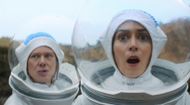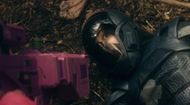The final episode of Black Mirror: Into Infinity Season 7, titled USS Callister: Into Infinity, brought back the world of the popular USS Callister story from Season 4, only this time, the scale was even bigger. A direct sequel, the 90-minute episode followed Nanette and her digital crew as they battled angry game players in deep space. But what really stood out was the sheer size and detail of the space battle sequences, which used 669 visual effects shots in total.
James MacLachlan, the episode’s VFX supervisor, confirmed that his team drew direct inspiration from Top Gun, Star Wars, Star Trek, and even old World War II fighter plane footage. To block out the sequence, they used paper darts in their office and filmed them on an iPhone to map the movement.
In an interview with Variety, he said,
“There was a lot of ‘Star Trek’...We trawled back through that and had a look at how the camera moves, and how the objects react,”
They aimed to keep the momentum tight, energetic, and grounded in gaming culture, even including a shoutout to World of Warcraft's Leeroy Jenkins.
From hyperspace effects inspired by smoke machines at discos to teleporting scenes shot using handheld motion control and synced lighting, every part of the episode was designed with practical tools first, then layered with effects. The result was an ambitious mix of sci-fi and gaming done with serious technical planning.
From Top Gun to Star Wars: The visual playbook behind Black Mirror: Into Infinity’s space combat

When it came to building the space battle in USS Callister: Into Infinity, James MacLachlan and his visual effects team didn’t start with computers or animation software. The Black Mirror: Into Infinity team began with paper darts. Inside the production office, they threw makeshift ships around and recorded the movements on iPhones.
This rough footage helped them figure out how ships would move, turn, and react under pressure. Once the movements felt right, they translated them into digital sequences. That lo-fi process was rooted in the idea of keeping the battle practical in spirit, even when the visuals would eventually be rendered using complex VFX tools.
MacLachlan also said they wanted to,
“be as punchy as we could because we knew each of the sequences were quite condensed, but we knew that what we wanted to do was keep the energy levels at the right level.”
The space battle wasn’t just built from scratch. It was shaped by scenes and camera styles seen in Top Gun, Star Wars, Star Trek, and even Rush. MacLachlan’s team pulled footage from all of them. They studied how cameras followed fighter jets in Top Gun and how spacecraft banked and weaved in Star Wars trench runs.
They looked at Rush for how tension was built between characters through visual pacing. They even examined aerial combat footage from World War II to understand how real pilots moved and responded under pressure. The Black Mirror: Into Infinity team wanted that same energy in scenes where digital characters were flying digital ships.
To bring the gaming feel in, MacLachlan and showrunner Charlie Brooker added design elements like printed circuit boards and microchips to parts of the space environment. Instead of smooth steel, some of the objects were textured with patterns that looked like they came out of a motherboard.
This design choice helped ground the battle in the digital world of the game. The audio team also played a part. The yell of “Leeroy Jenkins” is heard at a key moment, an intentional nod to World of Warcraft that ties the chaos of online games into the action on screen.
The visual design of the hyperspace sequence was another area where specific inspiration played a role. MacLachlan remembered how smoke machines and laser lights at discos created a hazy tunnel effect.
That memory shaped how the hyperspace beams looked, dense, colored with purple and cyan, and filled with motion. Instead of making hyperspace a blank backdrop, the team designed it to feel like a physical space the ship was moving through.

Cloning and teleporting sequences used motion control and synced lighting cues. The cast of Black Mirror: Into Infinity, including Cristin Milioti, helped test out shots in the production offices using handheld cameras.
When it was time to film the teleportation, cinematographer Stephan Pehrsson shot handheld while the lighting team synced lights to pre-programmed animations. This allowed them to trigger specific lighting changes that matched teleportation effects without needing to rely entirely on digital effects.
Every piece of the space battle and surrounding sequences of Black Mirror: Into Infinity was built from a mix of basic tools, layered references, and specific planning. Nothing was thrown in for style. Each element was either grounded in gaming, pulled from classic films, or built using real-world models, lights, and camera movement first.
Follow for more updates.
